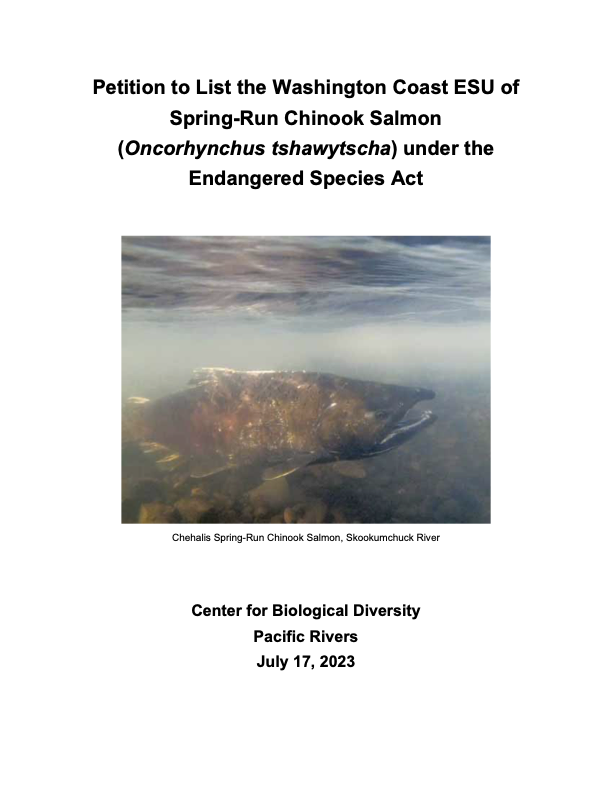Click here to view the full document. |
We are very pleased to report that our petition to protect Washington coast spring Chinook salmon under the Endangered Species Act is moving forward.
On December 7, 2023, the National Marine Fisheries Service announced an initial finding that ESA protections may be warranted. NMFS will now initiate a status review for Washington coast spring-run and fall-run salmon populations. “Our petition presented data showing that spring-run Chinook are genetically distinct from fall-run salmon, and that they are critically imperiled in the rivers of the Washington coast,” said Mike Morrison, Pacific Rivers’ Board Chair. “The data we provided the agency also bolsters the case for other petitions already pending for springers in other Northwest rivers.” The agency will evaluate the status and threats for salmon in the Chehalis, Quinault, Queets, Hoh and Quillayute river basins on the west coast of the Olympic Peninsula. It will begin by “soliciting scientific and commercial data, including traditional ecological knowledge pertaining to Chinook salmon that spawn north of the Columbia River and west of the Elwha River from any interested party.” |
Washington coast spring Chinook have declined significantly and are now at a fraction of their historical abundance, with an average of only 3,200 adult spawning fish returning annually to Washington coast rivers. Spring Chinook are depleted because of habitat degradation due to dams, logging and roads, water diversions, and migration barriers that block suitable spawning habitat and prevent upstream and downstream migration. They are also threatened by a proposed new dam in the upper Chehalis River, harvest in ocean commercial fisheries and climate change.
For decades, fisheries managers and others have generally assumed that if spring Chinook disappeared, fall Chinook would simply replace them, because they were essentially the same fish. Recent genetic evidence has shown otherwise.
Over the last decade, Dr. Michael Miller and his research team at UC Davis have confirmed that spring Chinook salmon are genetically distinct from fall Chinook salmon. Today we know which unique genetic attributes created their ability to enter freshwater early and migrate far upstream. We also know that springers’ unique characteristics did not arise independently in each watershed. They are the result of a single genetic mutation millions of years ago that was followed by unique adaptations over immense spans of time to the watersheds they inhabit today. There is no longer any reasonable basis for an assumption that spring Chinook salmon will magically “re-evolve” in any time frame meaningful to us if we lose them. What took nature eons to create cannot be replaced quickly. We can’t be sure it is possible at all.
But some things are certain. It is possible to lose springers. We can lose them in specific basins. (We already have.) We can lose them entirely. If we lose them, we will have lost them not just for people living today, but for untold generations to come.
The good news is that we now have a much better understanding of springers, an even stronger case for immediate action to save them, and a very good idea of what those actions must be. “This is a welcome step toward ensuring that we can keep viable salmon runs for future generations,” said Jeff Miller, a senior conservation advocate at the Center for Biological Diversity. “Early returning spring-run salmon are in trouble all along the West Coast, and Endangered Species Act protection could help stop their slide toward extinction.”
Now, these iconic, irreplaceable salmon are one step closer to federal protections.
For decades, fisheries managers and others have generally assumed that if spring Chinook disappeared, fall Chinook would simply replace them, because they were essentially the same fish. Recent genetic evidence has shown otherwise.
Over the last decade, Dr. Michael Miller and his research team at UC Davis have confirmed that spring Chinook salmon are genetically distinct from fall Chinook salmon. Today we know which unique genetic attributes created their ability to enter freshwater early and migrate far upstream. We also know that springers’ unique characteristics did not arise independently in each watershed. They are the result of a single genetic mutation millions of years ago that was followed by unique adaptations over immense spans of time to the watersheds they inhabit today. There is no longer any reasonable basis for an assumption that spring Chinook salmon will magically “re-evolve” in any time frame meaningful to us if we lose them. What took nature eons to create cannot be replaced quickly. We can’t be sure it is possible at all.
But some things are certain. It is possible to lose springers. We can lose them in specific basins. (We already have.) We can lose them entirely. If we lose them, we will have lost them not just for people living today, but for untold generations to come.
The good news is that we now have a much better understanding of springers, an even stronger case for immediate action to save them, and a very good idea of what those actions must be. “This is a welcome step toward ensuring that we can keep viable salmon runs for future generations,” said Jeff Miller, a senior conservation advocate at the Center for Biological Diversity. “Early returning spring-run salmon are in trouble all along the West Coast, and Endangered Species Act protection could help stop their slide toward extinction.”
Now, these iconic, irreplaceable salmon are one step closer to federal protections.

